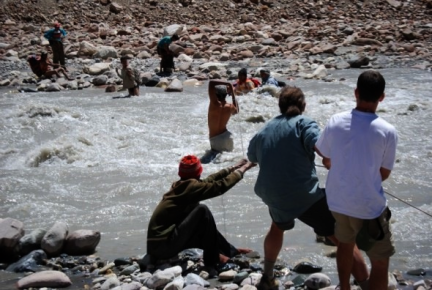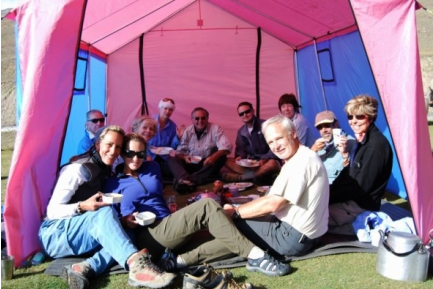14,000 feet, our final night’s campsite, and there was much to be inspired about: the thousand-year-old monasteries, the glaciers, the smiles and goodness emanating from the people and the Dalai Lama himself; an ever-deepening friendship with my partner Ankit along with Bicky and all our Hindi friends and crew; most rewarding was how, once again, shared experience had morphed our traveling circus of trekkers into a loving family.
There had been moments of true adventure. Almost too much adventure as we crossed the roiling waters on our trek from Chandra Tal to Baralacha La. Ironically, the experience had been strangely reminiscent of the kind of team–building experiences I had contrived innumerable times for executive teams on resort properties around the world over the last two decades. This time however the stakes were entirely different. We were not in some hotel ballroom. And the elements were playing for keeps.
The instructions: ‘Get your entire team across the raging river in the least time possible. The river is rising so fast that every minute counts and if anyone gets swept away the whole team loses!’
Warm weather had caused the glacier fed streams to become angry, freezing torrents. Large boulders trundled along their bottom. As the sun rose higher we could actually watch the water levels rise, their power and intensity – and the danger – increase with each passing moment.
And we had won. No one lost, no one injured. Everyone filled with the adrenalin of adventure. Mission accomplished.
But it was there, upon that sunny day, as I sat by glorious stream and mountain meadow, the true gift slowly arrived. That day I had a clear answer to my ceaseless wondering on the purpose of my life. At age fifty-four, I’ve lived all my dreams – personal and professional – so why am I still here?
The answer came fast and clear: I am here to serve others.
It was a magic moment piled atop other magic moments. A matter of days before – up a terrible road just a few scant miles from the Tibetan border – we had been among the handful of fortunate foreigners at the feet of the Dalai Lama as he reached deep to offer the root of Tibetan Buddhist teaching: the importance of bodhicitta.
The Tibetan word for bodhicitta is “jang chub chi sem.” Meaning not just the enlightened but literally ‘the most selfless mind’. No more self-cherishing, no more self-centeredness. Complete love, complete compassion. One that has love and compassion towards all beings. Every sentient being.
In the words of the Dalai Lama: “In true bodhicitta no one is excluded. It includes every sentient being. Always, forever and forever. Ever and ever. We have love and compassion, but we don’t have love and compassion all the time, because all of a sudden we become angry. All of a sudden selfish mind arises. And sometimes we have love and compassion to certain people, and we don’t have for certain people. It’s a partial love, partial compassion.”
We can and must do better.
As I sat in reflection during our high camp rest day, the reason for my pilgrimage became obvious. I had come all the way around and to the very top of the world for this reminder: we live, we explore, we work – only for one reason – to become wider, deeper and every way better in our efforts live in loving kindness.
As all things personal are in their ultimate expression political, this is the very challenge of our time. Not to love just some, the easy targets – our family and friends, our countrymen – but all. On this increasingly divided and fractious planet, this is the mission we all share. The quest began here in the Himalayas, but it is one we shall undertake in earnest only upon our return.
Returning along mountain roads that final day we glimpsed what looked like Shangri-la; small villages across the river in the Lahoul Valley – peaceful, glorious beneath the sheer mountainsides and glaciers. But for us Westerners Shangri-la must no longer remain a place just across the river and out of reach. The adventure now is to somehow bring that touch of wisdom and grace back to our daily, no-longer ordinary lives.
Those who have not been there ask: “Why do you climb to the top of the world?” Those that have don’t ask. They know. To ‘Enjoy the View’.
Not just a view of jagged peaks and glaciers with rolling moraines beneath walls of ice, but glimpses of our own lives from a fresh and heightened perspective. To return with gifts gathered from the mountain top, a vision and inner map that will enable us to navigate wisely through the lives to which we return.
For all of us on the Mountains and Monasteries Expedition 2007 the views were different. But for none of us will the world below ever be the same.







